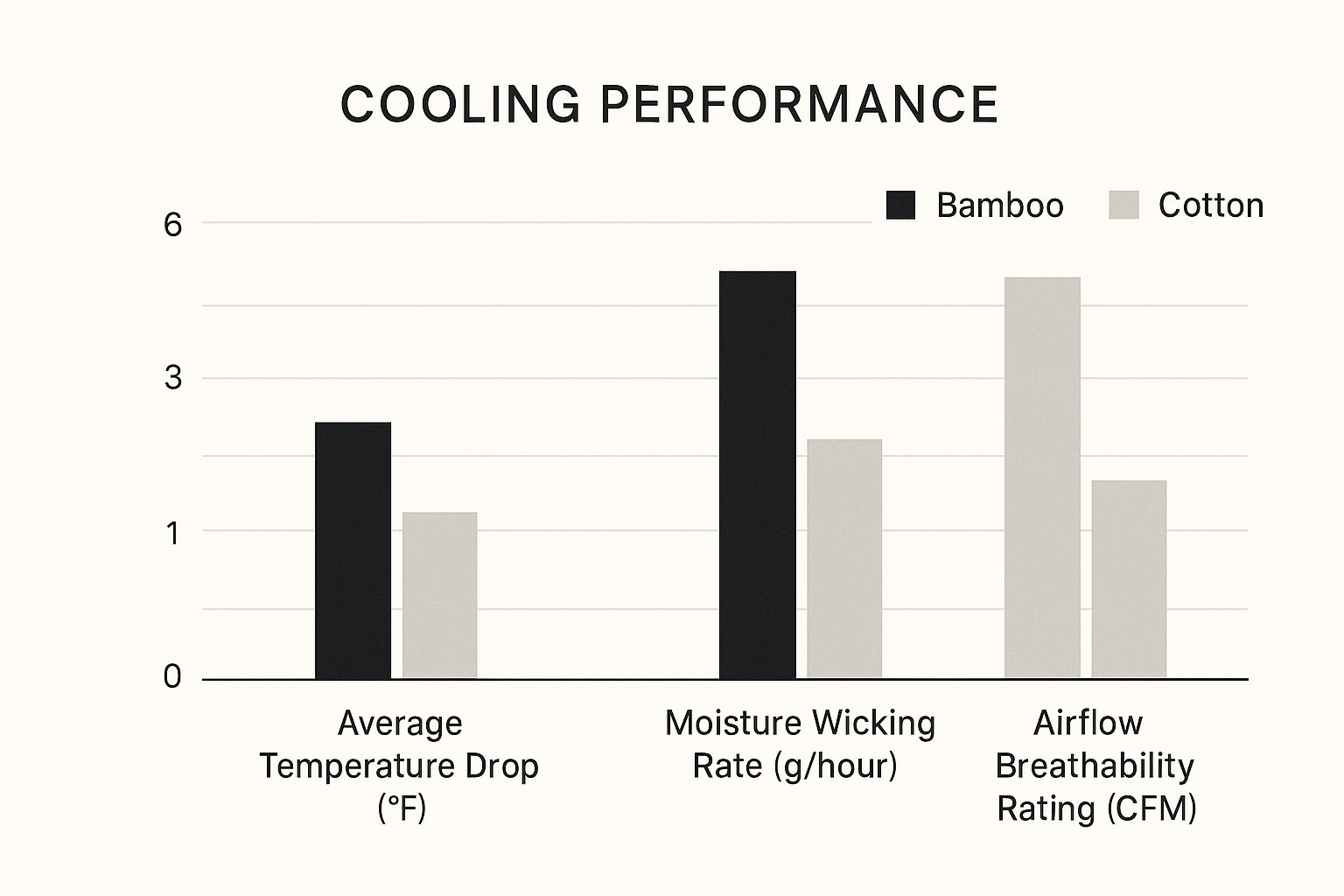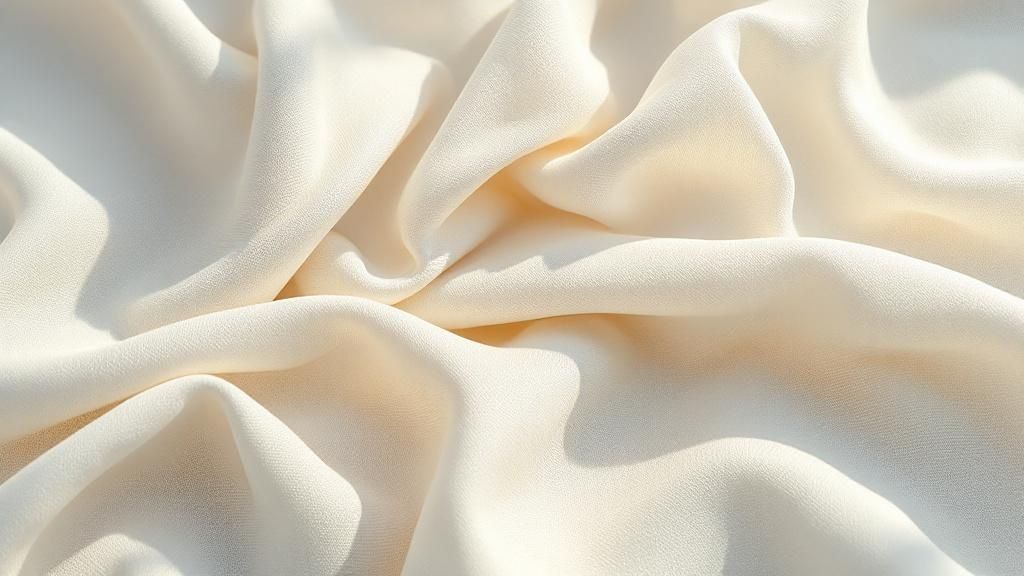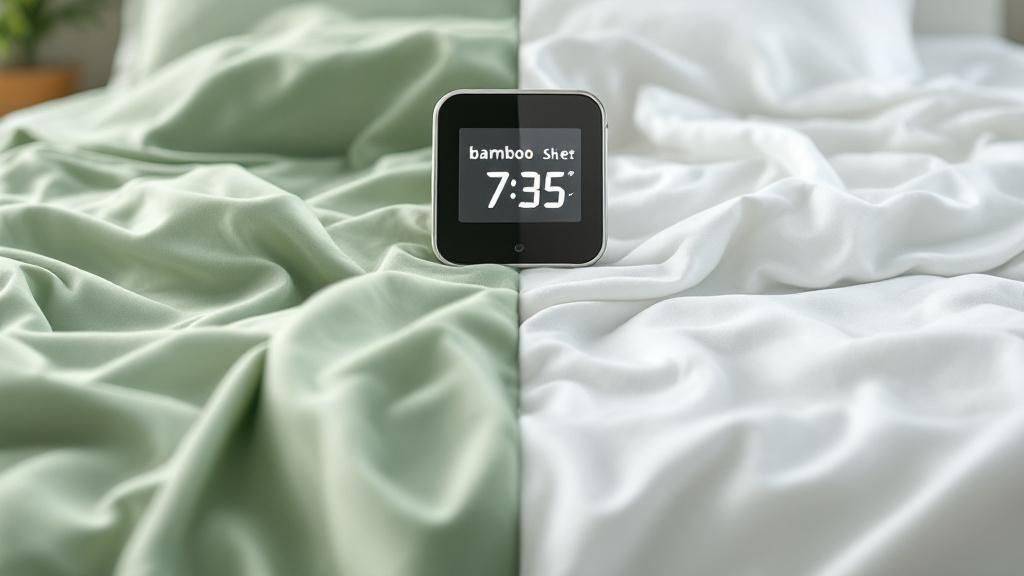Yes, bamboo sheets absolutely help you stay cooler at night. Their reputation as a hot sleeper's best friend isn't just clever marketing—it's grounded in the unique properties of the fabric itself. If you're someone who constantly battles overheating, they can be a real game-changer.
The Science Behind Bamboo's Cooling Power
So, what’s the secret behind bamboo's temperature-regulating magic? It really boils down to how the fabric is constructed and the natural characteristics of bamboo fibers. Think of it less like a material that traps heat (like some synthetic fabrics) and more like a smart system that works with your body to maintain a comfortable sleep climate.
This isn't just about that initial cool-to-the-touch sensation when you first climb into bed. It's about maintaining that comfort all night long. There are really three key elements at play:
- Incredible Breathability: The weave of bamboo fabric is filled with microscopic holes that let air flow freely. This constant ventilation is what allows your body heat to dissipate instead of getting trapped under the covers.
- Superior Moisture-Wicking: Bamboo fabric is exceptionally absorbent. It actively pulls sweat away from your skin, which is crucial for preventing that clammy, sticky feeling that so often wakes people up.
- Natural Thermo-Regulation: The fibers themselves have an inherent ability to adjust to your body temperature. This means they help keep you cool when you're warm but also provide a comfortable warmth when it gets chilly, making them fantastic for year-round use.
At its core, the reason bamboo sheets keep you cooler is their unique micro-structure. This design promotes fantastic airflow, letting heat escape rather than being trapped against your skin.
A Quick Comparison With Cotton
When people are looking for cooling sheets, the conversation often comes down to bamboo versus cotton. While both are natural fibers, they perform very differently when it comes to heat and moisture.
Here’s a simple table to help you see the key differences at a glance:
| Feature | Bamboo Sheets | Traditional Cotton Sheets |
|---|---|---|
| Breathability | High, with a porous weave that promotes airflow. | Moderate, but can vary greatly by weave (e.g., sateen vs. percale). |
| Moisture-Wicking | Excellent; absorbs moisture quickly and moves it away from the skin. | Good, but can become damp and heavy when saturated with sweat. |
| Feel | Silky, smooth, and drapes well over the body. | Can range from crisp and cool (percale) to soft and cozy (sateen). |
| Thermo-Regulation | Actively adapts to body temperature, feeling cool in summer and warm in winter. | Less adaptive; primarily relies on the weave for its cooling properties. |
As you can see, while high-quality cotton can be a good option, bamboo consistently comes out ahead in the categories that matter most for hot sleepers.

The data really backs this up. Bamboo fabric has been shown to stay about 3°F cooler than cotton and can absorb 40% more moisture. For anyone dealing with night sweats, that difference is huge. You can discover more insights about bamboo's cooling properties on bedvoyage.com to see just how effective it can be.
Ultimately, this powerful combination of features leads to a drier, cooler, and more restful night's sleep.
How Bamboo Fabric Manages Heat and Moisture
To really get why bamboo sheets feel so cool, we have to look closer at the fabric itself. It’s not just a clever marketing term; the cooling effect comes from the way bamboo fibers are built on a microscopic level. It's a bit of natural engineering that makes for a comfortable night's sleep.
Think of bamboo fabric less like a solid sheet and more like an intricate, porous web. The fibers are naturally filled with tiny gaps and holes, which creates a weave that breathes incredibly well. This structure is key—it lets air move freely, so your body heat doesn't get stuck under the covers with you.

This constant air exchange is what experts call heat dissipation. Instead of trapping your warmth like an insulator, bamboo sheets actively help that heat escape. The result? The surface of your bed stays noticeably cooler to the touch all night long.
The Science of Wicking Sweat Away
But exceptional breathability is only half of the equation. The other critical piece is how bamboo fabric deals with moisture, which is a game-changer for anyone who sweats at night.
Bamboo viscose fibers are superstars at absorption—way more absorbent than old-school cotton.
They essentially act like tiny sponges, pulling sweat away from your skin almost instantly. This is a process known as moisture-wicking. But it doesn't just stop there. Once the moisture is drawn into the fabric, it's spread out over a much larger surface area. This, combined with that fantastic airflow, allows the moisture to evaporate incredibly fast, leaving you feeling dry, not damp.
This one-two punch of releasing heat and evaporating moisture is what makes bamboo sheets so powerful. They don't just feel cool; they actively work to lower the temperature and humidity right where you sleep.
This dynamic system is a huge step up from other materials. Cotton, for instance, can soak up moisture, but it tends to hang onto it, leaving you with heavy, damp sheets. Synthetic fabrics like polyester don't absorb much at all and can trap both heat and sweat right against your skin.
This is exactly why 100% bamboo viscose is what you should look for if you want the best cooling performance. When bamboo is blended with other materials, its natural thermoregulating abilities can be watered down.
If you want to get even deeper into the science, you can find more details in our complete guide explaining why bamboo sheets are a cooling choice. It’s this complete process that keeps you truly comfortable, not just momentarily cool.
Why Hot Sleepers Are Switching From Cotton to Bamboo
If you're someone who constantly battles the heat at night, you know that your choice of sheets is about more than just comfort—it's about survival. I've talked to countless people who've made the switch from cotton to bamboo, and the reason is almost always the same: performance.
While cotton is a classic, it has a major drawback for warm sleepers. It's an absorbent fiber, meaning it soaks up sweat and holds onto it. This creates that heavy, damp feeling that wakes you up in the middle of the night. Bamboo, however, works completely differently. It actively pulls moisture away from your skin and allows it to evaporate, keeping you dry and comfortable.

The Real-World Cooling Difference
This isn't just about how the fabric feels—the numbers back it up. Studies have shown that bamboo sheets can actually lower the surface temperature by a noticeable 3 to 5°F compared to cotton, which tends to trap body heat. That might not sound like a huge number, but for anyone dealing with hot flashes or night sweats, that slight drop can be the difference between a restless night and a restorative one.
So, how does it work? It all comes down to the microscopic structure of the fibers. Bamboo's weave is filled with tiny gaps that make it roughly two times more breathable than its cotton counterpart. This unique structure lets heat escape instead of building up around your body.
I often tell people that if you've ever woken up feeling sticky and overheated, bamboo offers a genuine fix. It manages both temperature and humidity in a way that creates a consistently cool and dry sleep environment, which is where cotton often fails.
It's Not Just About Staying Cool
Beyond its impressive temperature-regulating abilities, bamboo brings another major advantage to the bed: it's naturally antimicrobial. The bamboo plant itself has a bio-agent that helps it fend off pests and fungi, and this incredible property stays with the fabric.
This translates into two key benefits for you:
- Your sheets stay fresher, longer. The fabric naturally resists the growth of odor-causing bacteria.
- A cleaner sleeping surface. This creates a more hygienic space, which is a huge plus, especially for anyone with sensitive skin.
When you add it all up—superior cooling, moisture-wicking, and natural hygiene—the case for bamboo becomes pretty clear. For a deeper dive, check out our post on why bamboo is such an eco-friendly choice for hot sleepers. For anyone genuinely looking for relief from overheating, bamboo simply offers a more complete and effective solution than traditional cotton.
So, you're sold on the idea that bamboo sheets can keep you cool. Great! But now comes the tricky part: picking the right set. The market is flooded with options, and honestly, not all "bamboo" bedding is the same. A few key details can be the difference between a cool, comfortable night and a sweaty, restless one.
Let's cut through the marketing fluff and get down to what actually matters.

When you know what to look for—specifically the material, weave, and certifications—you can be confident you're buying sheets that will actually deliver on their cooling promise.
Decoding Fabric Labels and Metrics
First thing's first: check the label. For the best cooling effect, you want sheets made from 100% bamboo viscose or lyocell. It's common to see bamboo blends mixed with cotton or microfiber, but these can seriously compromise the breathability and moisture-wicking power that makes bamboo so great in the first place.
Now, let's talk about thread count. With cotton, we've been trained to think higher is better, but you need to throw that rule out the window for bamboo. Pushing the thread count too high on bamboo fabric can actually trap heat by making the weave too dense. A moderate thread count, somewhere in the 250 to 400 range, is the sweet spot. It gives you that signature silky feel without sacrificing airflow.
Another spec you might see is GSM, which stands for grams per square meter. It’s a measure of the fabric’s weight. For bamboo sheets, a GSM of 100 or more indicates good quality, durability, and absorbency. Some research suggests that a GSM around 144 hits a perfect balance, feeling lightweight while still being effective. If you want to dive deeper into the science, you can read the full analysis on cooling bamboo sheets to see how these numbers play out in real-world performance.
My personal tip? Ignore the temptation of a sky-high thread count. For bamboo, breathability is king, and a moderate count of around 300 is often the sweet spot for staying cool all night long.
Certifications That Matter
Finally, don't overlook the certifications. These little labels are your assurance that an independent third party has tested the sheets and verified their quality and safety. It's an easy way to spot a reputable brand.
Here are the main ones to keep an eye out for:
- OEKO-TEX Standard 100: This is the big one. It guarantees that every single component—from the fabric right down to the thread and buttons—has been tested and found free of harmful chemicals.
- Organic 100 Content Standard (OCS 100): This certification confirms the product is made with 95-100% organic material, which is a huge plus.
Choosing sheets with these credentials, like some of the options from Bamtek, gives you peace of mind. You’re not just getting bedding that’s cool and buttery-soft; you’re getting a product that’s safe for your skin and your home. It’s a simple check that ensures you’re bringing home quality, not just clever marketing.
Keeping Your Sheets Cool for the Long Haul
So you've invested in some amazing cooling sheets. Fantastic! But to make sure they keep delivering those cool, comfortable nights, you have to treat them right. The very things that make bamboo fabric so breathable—those unique fibers—are also what make them a bit sensitive to harsh washing.
A little bit of care goes a long way. Following a few simple rules will keep them feeling silky soft and working their cooling magic for years to come.
The number one enemy of bamboo fabric is high heat. I’ve seen it happen—hot water washes and high-heat dryer cycles can absolutely ruin the delicate fibers. This kind of heat makes them shrink and weaken, stripping away that signature smooth texture. Once that happens, airflow is reduced, and their cooling power just isn't the same.
Washing and Drying Done Right
Always, and I mean always, wash your bamboo sheets in cold water. Stick to a gentle cycle and keep the temperature at 30°C (86°F) or below. This is probably the single most important thing you can do to protect the fabric.
Also, be picky about your detergent. Go for something mild and pH-neutral, and definitely skip the fabric softeners and bleach. Those products leave a residue that clogs the tiny pores in the fabric, which is exactly what you don't want. Those pores are what make the sheets so breathable in the first place.
When it's time to dry, you have a couple of great choices:
- Line dry them: This is by far the best method. It’s incredibly gentle on the fibers and saves a little energy, too.
- Tumble dry on low: If you need to use a machine, just make sure it’s on the lowest heat setting possible. A no-heat, air-dry cycle is even better.
Gentle care is the secret to making your sheets last. Treat them well, and they'll keep you cool night after night. That's the whole point, right?
Following these tips helps you sidestep annoying problems like pilling or the fabric breaking down over time. For a full breakdown, check out our guide on how to care for your bamboo sheets. A simple routine is all it takes to make sure your bedding remains your best friend in the fight for a cool night's sleep.
Your Top Questions About Bamboo Cooling Sheets, Answered
Even after learning how bamboo sheets can help you sleep cooler, you might still have a few questions. That's completely normal. Let's tackle some of the most common ones I hear, so you can make your decision with confidence.
"Will I feel cold all night long?"
This is a great question. While bamboo sheets have a noticeably cool feel when you first slip into bed, their real talent is in thermo-regulation.
Think of it less as an air conditioner and more as a smart thermostat. They don't just make you cold; they adapt to your body, wicking away excess heat and moisture to keep you at that "just right" temperature. The goal is to prevent overheating, not to leave you shivering.
"Are bamboo blends just as good for staying cool?"
I get asked this a lot, and the honest answer is no, not really. When you see a blend—often with cotton or a synthetic like microfiber—you're diluting the very properties that make bamboo so effective.
While those blends might be a bit cheaper, they simply can't match the breathability and moisture-wicking power of 100% bamboo viscose. If you're a hot sleeper looking for maximum relief, sticking with pure bamboo is always your best bet.
"Are they only good for the summer?"
Not at all! This is where that amazing thermo-regulating ability comes back into play. The same breathable weave that releases your body heat in the summer also works to keep you cozy in the winter.
It traps a thin layer of air close to your body, providing just enough insulation to keep you comfortably warm without causing you to sweat.
The magic of bamboo is its adaptability. It's not just a 'cooling' sheet; it's a 'temperature-balancing' sheet, making it perfect for comfortable, year-round sleep.
Ultimately, bamboo sheets work with your body to create a stable, pleasant sleep environment, no matter what the season. They smooth out those frustrating temperature swings that wake you up.
Ready to experience balanced, comfortable sleep all year round? Discover the difference with Bamtek's 100% organic bamboo viscose sheets, certified by OEKO-TEX for your peace of mind. Find your perfect set at bamtekhome.com.










